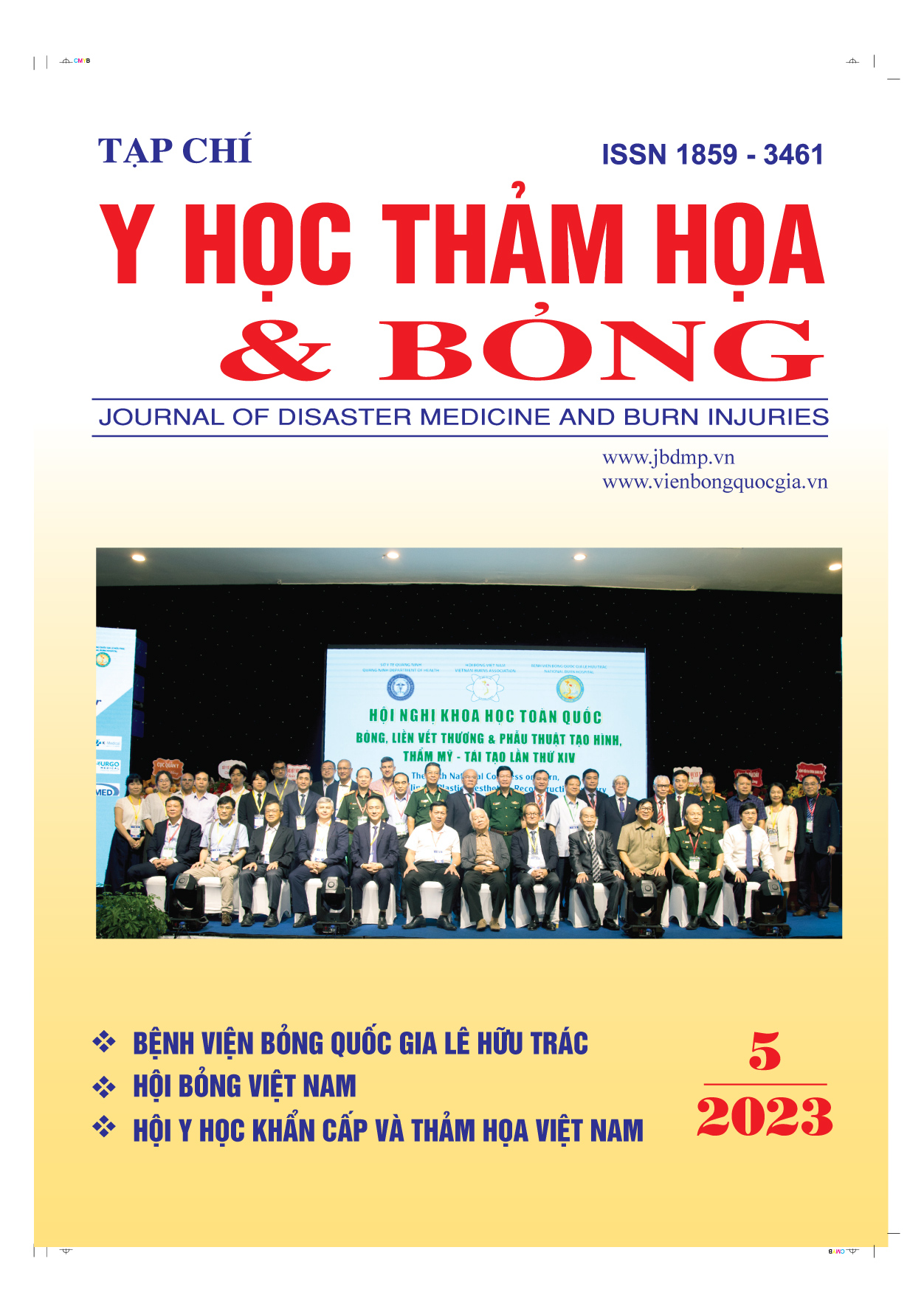Characteristics and prognostic factors of mortality in burns patients at the Cho Ray Hospital from 2020 to 2022
Main Article Content
Abstract
Objectives: Evaluation of characteristics, treatment results, and some predictive factors of death in burn patients at Cho Ray Hospital from 2020 to 2022.
Method: Retrospective study on 2,053 data of burn patients from January 2020 to December 2022 inpatient treatment at Cho Ray Hospital.
Result: The average number of days of treatment was 18.2 days. The median number of days of treatment in survivors was 19.6 days and in patients who died was 10.1 days. Women have an average longer number of treatment days than men. Patients of working age, who are rural and have health insurance have a longer average number of treatment days. Patients with electrical burns had the longest average number of treatment days at 28.7 days. The average number of days of treatment extended according to the severity of the burns and V-degree burns had the longest average number of treatment days at 34.6 days. Common complications were sepsis (4.97%), septic shock (3.9%), acute renal failure (2.78%), pneumonia (1.7%), and mycosis (1.32%). The overall mortality rate was 14.7%. The patient has a general burn area, and the larger the area of deep burns, the higher the mortality rate. Burn patients with mental and behavioral disorders have a mortality rate of 50%. Age, respiratory burns, burn area, deep burn area, surgery, and comorbid mental and behavioral disorders are the strongest factors in the prognosis of death.
Conclusion: The average number of days of treatment was 18.2 days. Patients with electric burns, and deep burns have the longest average number of days of treatment. The overall mortality rate was 14.7%. The mortality rate is directly proportional to the general burn area and the area of deep burns. Age, respiratory burns, burn area, deep burn area, surgery, and accompanying mental and behavioral disorders are the strongest prognostic factors of death.
Article Details
Keywords
Characteristic, mortality, burn, burn patients
References
2. Anami E. H. T., Zampar E. F., Tanita M. T., et al. (2017), "Treatment costs of burn victims in a university hospital", Burns, 43 (2), pp. 350-356.
3. Bảo hiểm xã hội Việt Nam. BHXH Việt Nam luôn đồng hành, đặt quyền lợi tối đa cho người tham gia BHYT. 2023; Available from: https://baohiemxahoi.gov.vn/tintuc/Pages/linh-vuc-bao-hiem-y-te.aspx?ItemID=20016&CateID=0.
4. Institute for Health Metrics and Evaluation. Global Burden of Disease (GBD). 2019; Available from: https://vizhub.healthdata.org/ gbd-results/.
5. Kruger E., Kowal S., Bilir S. P., et al. (2020), "Relationship Between Patient Characteristics and Number of Procedures as well as Length of Stay for Patients Surviving Severe Burn Injuries: Analysis of the American Burn Association National Burn Repository", Journal of Burn Care & Research, 41 (5), pp. 1037-1044.
6. Ngô Minh Đức, Chu Anh Tuấn, Lê Quốc Chiểu (2021), "Đặc điểm bỏng hàng loạt và kết quả điều trị: Số liệu 5 năm tại Bệnh viện Bỏng Quốc gia (2016 - 2020)", Tạp chí Y học Thảm hoạ và Bỏng, (3), tr. 12-20.
7. Ngô Minh Đức, Chu Anh Tuấn, Nguyễn Gia Tiến và cộng sự (2020), "Đặc điểm và một số yếu tố tiên lượng tử vong ở bệnh nhân bỏng: Dữ liệu tại Bệnh viện Bỏng Quốc gia trong 10 năm (từ 2010 đến 2019)", Tạp chí Y học Thảm hoạ và Bỏng, (1), tr. 7-22.
8. Ngô Tuấn Hưng, Nguyễn Như Khánh, Nguyễn Quang Hiếu (2022), "Cơ cấu và các yếu tố ảnh hưởng đến chi phí điều trị bệnh nhân bỏng nặng", Tạp chí Y học Thảm hoạ và Bỏng, (3), tr. 47-53.
9. Nguyễn Ngọc Tuấn (2018), "Giáo trình Bỏng", Nhà xuất bản Quân đội Nhân dân, Hà Nội.
10. WHO. Burn. 2018; Available from: https://www.who. int/ news-room/fact-sheets/detail/burns.
11. Yakupu A., Zhang J., Dong W., et al. (2022), "The epidemiological characteristic and trends of burns globally", BMC Public Health, 22 (1), pp. 1596.
12. Lip H. T. C., Idris M. A. M., Imran F. H., et al. (2019), "Predictors of mortality and validation of burn mortality prognostic scores in a Malaysian burns intensive care unit", BMC Emerg Med, 19 (1), pp. 66.
13. Mulatu D., Zewdie A., Zemede B., et al. (2022), "Outcome of burn injury and associated factor among patient visited at Addis Ababa burn, emergency and trauma hospital: a two years hospital-based cross-sectional study", BMC Emerg Med, 22 (1), pp. 199.
14. James S. L., Lucchesi L. R., Bisignano C., et al. (2020), "Epidemiology of injuries from fire, heat and hot substances: global, regional and national morbidity and mortality estimates from the Global Burden of Disease 2017 study", Inj Prev, 26 (Supp 1), pp. i36-i45.
15. Abdel Wahab M. E., Sadaka M. S., Elbana E. A., et al. (2018), "Evaluation of prognostic factors affecting length of stay in hospital and mortality rates in acute burn patients", Ann Burns Fire Disasters, 31 (2), pp. 83-88.
16. Sheckter C. C., Pham C., Rochlin D., et al. (2020), "The association of burn patient volume with patient safety indicators and mortality in the US", Burns, 46 (1), pp. 44-51.
17. Ghaed Chukamei Z., Mobayen M., Bagheri Toolaroud P., et al. (2021), "The length of stay and cost of burn patients and the affecting factors", Int J Burns Trauma, 11 (5), pp. 397-405.
18. Mason S. A., Nathens A. B., Byrne J. P., et al. (2017), "Trends in the epidemiology of major burn injury among hospitalized patients: A population-based analysis", J Trauma Acute Care Surg, 83 (5), pp. 867-874.
19. Saavedra P. A. E., De Oliveira Leal J. V., Areda C. A., et al. (2021), "The Costs of Burn Victim Hospital Care around the World: A Systematic Review", Iran J Public Health, 50 (5), pp. 866-878.
20. Güldoğan C. E., Kendirci M., Gündoğdu E., et al. (2019), "Analysis of factors associated with mortality in major burn patients", Turk J Surg, 35 (3), pp. 155-164.


